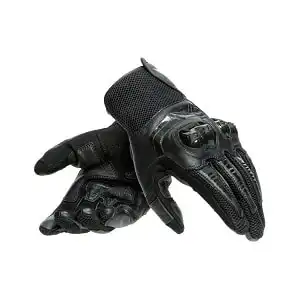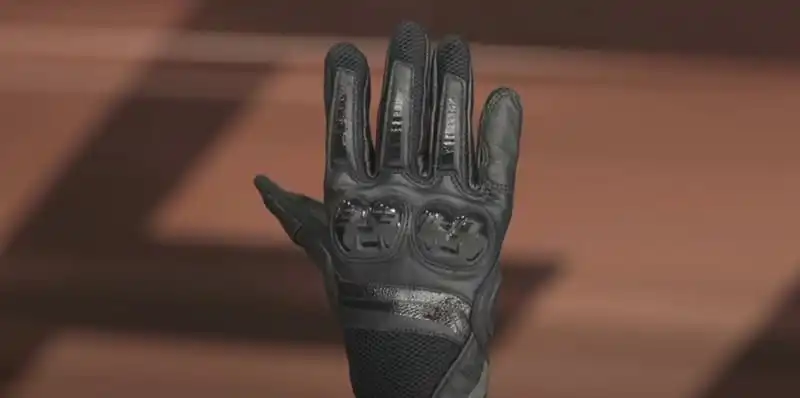I’m always on the lookout for high-quality riding gloves that provide protection without sacrificing comfort and flexibility.
So when the updated Dainese Mig-3 leather summer motorcycle gloves were released, I was keen to check them out and see if they live up to the reputation of the original Mig gloves.
But, the main question I will answer in this review will be: Are these the best motorcycle gloves for the summer for you? Let’s find out!
Dainese MIG 3 Leather Gloves Review

Key Takeaways
- All-rounder glove with value
- Updated classic design endures
- Balances protection and flexibility
Our Verdict Of The New Mig-3 Leather Motorcycle Gloves
I was excited to take the new Mig-3 summer motorcycle gloves (1) for a spin and experience the changes firsthand. Slipping my hands in, I immediately noticed the looser fit around the wrist and fingers.
The reworked panels and fabrics definitely provide more airflow to the hands and knuckles. However, the bulky wrist cuff now seems disproportionate next to the slimmer gloves. I prefer the more tailored shaping of the old Migs in this area.
The Amara palm lining feels pleasantly soft and supple, if slightly slick at first. The textured grip should improve once worn in. The divided pinky panel and stretch gussets do help mobility in tight spots.
Speaking of materials, I’m concerned about the decline in leather quality compared to earlier Dainese gear.
The hide feels thinner and more plastic-y, lacking that premium luxury touch. Minor quibbles aside, the new gloves appear decently constructed with tidy stitching throughout.
A Brief Background

For those unfamiliar, Dainese is an iconic Italian manufacturer of premium motorcycle gear. Their products are known for incorporating innovative safety technology into stylish designs.
The Mig glove line has a cult following in the riding community and is known for delivering robust protection in a flexible, lightweight package.
The previous version, the Mig-2 motorcycle gloves, debuted way back in 2014. After nearly a decade, Dainese has now released the successor Mig-3 model.
But with such big shoes to fill, the question is whether the new iteration retains everything riders loved about the Mig gloves.
I decided to scrutinize the upgrades to evaluate if these successor gloves warrant the $120 price tag.
Breaking Down the Changes
At first glance, the overall construction seems similar to the outgoing model. The gloves feature a combination of milled cowhide leather and 3D air mesh panels with durable faux suede palm reinforcements. The trim sporty styling remains unchanged as well.
However, peering closer reveals several key differences:
- Redesigned backhand panels – More 3D mesh now covers the back of the hand and wrist. The flexible lycra panels near the knuckles are gone too, replaced by leather.
- Extra ulna protection – Rigid TPU armor with shock-absorbing foam provides increased ulna coverage.
- Touchscreen fingertip conductivity – You can now use touchscreens without removing the gloves.
- Split pinky construction – The single-piece pinky panel is divided into two sections for flexibility.
- Modern style updates – Cleaner graphics and inverted colors freshen up the looks.
Interestingly, the gloves seem to share the same Amara synthetic suede palm as their predecessor. This material provides grip and abrasion resistance without breaking in like natural leather.
How Do They Stack Up to Competing Gloves?

| Product | Description |
|---|---|
| Alpinestars SMX1 Air V2 Gloves | Full goatskin construction with injected TPU and foam padding for protection. Perforated panels and stretch fabric for flexibility. No wrist closure. |
| Reax Castor Motorcycle Gloves | Synthetic microfiber construction with TPU knuckle and finger protection. Silicone textured palm grip. It lacks wrist support for safety but is affordable. |
| Bilt Spirit 3 Gloves | Synthetic microfiber construction with TPU knuckle and finger protection. Silicone textured palm grip. Lacks wrist support for safety but affordable. |
The Dainese MIG 3 strikes a balance between protection and comfort with its cowhide leather, TPU armor, and perforated panels.
It offers more impact padding than the minimalist Alpinestars but doesn’t reach the extreme protection levels of the Reax Castor racing gloves either. The Bilt Spirit 3 is much more basic and economical in comparison for casual riding.
The new Migs slot below hardcore track offerings adds more athletic flair over basic leather gloves. They balance mobility, ventilation, and safety for flexible street use – ideal for touring, commuting, and even casual rides.
If choosing just one pair for daily wear, I’d pick the Mig-3 over pricier specialist options that compromise versatility. They deliver great bang for the buck from a trusted brand.
Key Takeaways
To summarize my impressions on Dainese’s updated Mig-3 gloves:
- Good value: Solid protection features considering the reasonable price.
- Mixed upgrades: Some changes improve airflow but seem bulky around the wrist.
- Reliable safety: Armor offers ample impact and abrasion coverage for daily use.
While failing to exceed the previous gold standard Mig gloves, these modernized editions still deliver dependable performance. The revamp perhaps innovates too little rather than too much.
The gloves work well for comfortable short rides in warm weather. For colder or wet conditions, I would suggest opting for a fully waterproof winter glove instead.
Ultimately, the newest Dainese Migs retains the core DNA of versatility, protection, and value established by earlier models. Devotees of the Mig legacy should find these a worthy continuation of the lineage.
I’m keen to log more miles on the road with these gloves and see how they hold up over time. Feel free to share your experiences with the Dainese Mig gloves, too! Has anyone tested both versions and can compare the changes? Let me know your thoughts in the comments below.
Ride safe out there!
FAQs
How do the Mark II gloves improve over the previous version?
The Mark II gloves feature better ulna protection with rigid TPU armor and Knox Microlock foam compared to the Mark I’s minimal ulna slider. The knuckle armor also contains upgraded shock-dampening foam.
Would these gloves work for adventure touring?
Yes. The goatskin leather withstands abrasion from pavement as well as brush, while the armor protects against impact. The gloves provide an excellent feel for operating the motorcycle, too.
What is the difference between the Alton Mark II and Knox Handroid gloves?
The Handroid gloves carry heavier armor for rigorous track riding, whereas the Mk2’s focus is on maximizing street protection. However, the Altons retain more flexibility and better ventilation for comfortable street use.
Do the gloves have waterproofing?
No. For wet weather riding, applying a water-repellant spray or wearing rain gloves over the Knox Oultons is recommended. The glove materials shed light moisture but aren’t fully waterproof.
How long does the touchscreen compatibility last?
The conductive fingertips retain functionality for the lifetime of the gloves unless excessively worn down from abrasion. Light use preserves conductivity for years before needing replacement.
And finally, if you found this review useful, don’t forget to share it with your fellow riding buddies! Let’s keep each other safe on the road.
Previous Article:
Next Article:
Sources: MOTORCYCLE PROTECTIVE CLOTHING: (1)

